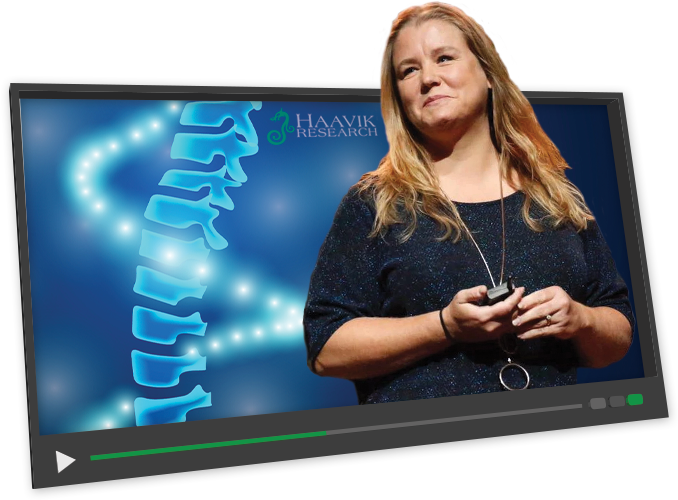
Learning the Science of Chiropractic Just got Easier!
Confidently communicate the proven benefits of chiropractic care. Create & grow a profitable practice.
The Progressive Education Framework for Chiropractors
Leading Edge Research
In-depth researched curriculum
No more scouring through research papers and trying to decipher.
Save $$$$$
A team of scientists teaching your staff
The world’s leading chiropractic scientists at a fraction of the cost of employing them.

“ChirosHub provides that just right balance, between the the complex subject matter and simplified explanation, needed in order to be the credible, effective and exciting teaching platform that you and your patients so need!”
Meet your Instructor

With 20+ years as a chiropractor, researcher, and neurophysiologist working in the area of human neurophysiology.
It is my mission to enlighten the world about the science of chiropractic.
Let me help grow your knowledge through science.
Dr. Heidi Haavik
- BS1.01 The Many Models of the Chiropractic Subluxation
- BS1.02 The Brain Model of the Chiropractic Subluxation
- BS1.03 Your first visit to a Chiropractor
- BS1.04 Your first adjustment
- BS1.05 How Stress Affects your Health
- BS1.07 Spinal Function affects Brain Function
- BS1.08 Adjustments Improve Strength
- BS1.09 The Prefrontal Cortex and Cerebellum
- BS1.10 How to Explain Pain
- BS1.11 Chiropractic and Pain
- BS2.01 Introduction to the Neuroplasticity Model
- BS2.02 Two Models of the Vertebral Subluxation
- BS2.03 The Neurophysiology of the Subluxation
- BS2.04 Chiropractic Adjustments affect the Prefrontal Cortex
- BS2.05 The Impact of Stress on the Brain and Health
- BS2.06 Communicating Chiropractic’s impact on the Brain
- BS2.07 Pain is created in the Brain
- BS2.08 Understanding Chronic Pain
- BS2.09 Connection between Stress, Pain, Sleep and Mental Health
- BS2.10 The Brain, Pain and the Neuroplastic Effects of Chiropractic Care
- BS2.11 The Somatosensory Neuroplastic effects of Chiropractic Care
- BS2.12 The Motor Control effects of Chiropractic Care
- CS1.01 Communicating Chiropractic Science
- CS1.02 The Safety of Chiropractic Care
- CS1.04 Lower Back Pain and Neck Pain
- CS1.05 Headaches and Migraines
- CS1.06 The Benefits of Chiropractic Care
- CS2.01 Chiropractic Care and Lower Back Pain
- CS2.02 Chiropractic Care and Neck Pain
- CS2.03 Chiropractic Care for Headaches and Migraines
- CS2.04 The Safety of Chiropractic Care
- CS2.05 Safety of Chiropractic Care for Kids and Babies
- CS2.06 The Opioid Crisis
- CS2.07 Chiropractic Care and Stroke Risk
- CS2.08 Clinical indicators of vertebral subluxations
- CS2.09 How Often Should You See Your Patients
- CS2.11 Chiropractic Care and Colic
- CS2.12 Chiropractic Care and Enuresis
- NS1.01 Neurobiology of the Neuron
- NS1.02 Neurobiology of the Glial Cells
- RM1.01 Introduction to Research Methodology
- RM1.02 Ethics in Research
- RM1.03 Evidence-Based Chiropractic
- RM1.04 Key Research Terminology
- RM1.05 Introduction to Different Research Designs
- RM1.06 Patient-Reported Outcome Measures
- RM1.07 Introduction to Experimental Designs
- RM1.08 How to do a Literature Search
- RM1.09 Introduction to Critical Evaluation
- RM1.11 How many participants you need for your study
- RM2.01 Science and Research for the Profession
- RM2.02 A Closer look at Critical Evaluation
- RM2.03 Writing for Academic Purposes
- RM2.04 A Closer look at evidence-based Chiropractic
- RM2.05 Gathering Scientific Evidence for a Report of Findings
- RM2.06 Observational Study Design
- RM2.08 Cross-sectional Studies
- RM2.12 How to write a Case Study
- RM3.01 A Closer Look at Experimental Designs
- RM3.02 Introduction to Randomized Control Trials
- RM3.03 A Closer Look at Randomized Controlled Trials
- RM3.04 Systematic Reviews
- RM3.05 Meta-analysis
- RM3.06 Narrative Reviews
- RM3.09 Working with your Supervisor on your Research Project
- RM3.10 Writing a Literature Review
- RM3.11 Writing a Research Proposal
- RM3.12 Writing and Presenting a Research Project
- SC1.01 Introduction to Biostatistics
- SC1.02 Basic Descriptive Analysis
Basic Science
Clinical Science
Neuroscience
Research Methods
Statistics
Basic Science
Online classes – 16
Each Basic Science class contains the latest scientific information about mechanisms. About what things are, and how things work relevant to chiropractic care.

Level ONE
For junior chiropractic students or chiropractic assistants who have not yet gained any in-depth knowledge about anatomy, physiology, or pathology.
Learn the facts about why good spinal function is so important, what happens when we adjust the spine, the detrimental impacts of stress and trauma, the important role of brain mal-adaptations in chronic pain, and how chiropractic care can improve strength and alter the prefrontal cortex and cerebellum function.
Level TWO
Aimed at those who have gained some knowledge about anatomy, physiology, pathology, neuroscience and research methodology, and science in general.
Dive deeper into what localized areas of spinal dysfunction (also known as vertebral subluxations) are. Learn about these central segmental motor control problems that lead to ongoing maladaptive central plastic changes, making it harder for the brain to accurately perceive what is happening inside the body and around it, why they occur and how this impacts health, brain (prefrontal cortex in particular), pain and function.
Level THREE
Aimed at a higher cognitive level including analysis, synthesis, and evaluation of anatomy, physiology, pathology, neuroscience, and research publications.
Learn how the CNS and the immune system interact, and the role of the spine in impacting these systems. Learn about the way that chiropractic high-velocity, low-amplitude thrusts at dysfunctional spinal segments enable the brain to more efficiently produce more force. How to monitor brain health with HRV and the impact on the Cerebellum and learn about what we know about the effects of different chiropractic techniques.
CLASS OUTLINE
- BS1.01 The Many Models of the Chiropractic Subluxation
- BS1.02 The Brain Model of the Chiropractic Subluxation
- BS1.03 Your first visit to a Chiropractor
- BS1.04 Your first adjustment
- BS1.05 How Stress affects your Health
- BS1.07 Spinal Function Affects Brain Function
- BS1.08 Adjustments Improve Strength
- BS1.09 The Prefrontal Cortex and Cerebellum
- BS1.10 How to Explain Pain
- BS1.11 Chiropractic and Pain
CLASS OUTLINE
- BS2.01 Introduction to the Neuroplasticity Model
- BS2.02 Two Models of the Vertebral Subluxation
- BS2.03 The Neurophysiology of the Subluxation
- BS2.04 Adjustments affect the Prefrontal Cortex
- BS2.05 The Impact of Stress on the Brain and Health
- BS2.06 Communicating Chiropractic’s impact on the Brain
- BS2.07 Pain is created in the Brain
- BS2.08 Understanding Chronic Pain
- BS2.09 Connection between Stress, Pain, Sleep and Mental Health
- BS2.10 The Brain, Pain and the Neuroplastic Effects of Chiropractic Care
- BS2.11 The Somatosensory Neuroplastic effects of Chiropractic Care
- BS2.12 The Motor Control effects of Chiropractic Care
CLASS OUTLINE
- Effect of spinal function and dysfunction on the brain (Coming Soon)
- The central nervous system (CNS) and immune system (Coming Soon)
- CNS, Chiropractic and the Immune System (Coming Soon)
- Strength increases with chiropractic adjustments (Coming Soon)
- Heart Rate Variability I (Coming Soon)
- Heart Rate Variability II (Coming Soon)
- Chiropractic and the Cerebellum I (Coming Soon)
- Physiology of manual muscle testing (Coming Soon)
- Basic Science of Applied Physiology (Coming Soon)
- Basic Science of Activator (Coming Soon)
“It was interesting to know how the stress can impact on our brain. Also the example of hand, wrist, fingers to explain the brain parts with its function was really helpful for making the patients understand easily.”
Clinical Science
Online classes – 16
The latest scientific information about the efficacy and/or safety and/or cost-effectiveness of chiropractic care and other health care options for various conditions and disorders.

Level ONE
For junior chiropractic students or chiropractic assistants. This course aims to increase knowledge and comprehension to aid patient-focused, evidence informed chiropractic practice.
Learn the facts about the safety of chiropractic care, even for kids and babies. Learn the facts about the efficacy and cost-effectiveness of chiropractic care for low back pain, neck pain, headaches, and migraines. Learn what science we have for chiropractic care improving posture, golf, older adults, breastfeeding, colic, bedwetting, ear infections, growing pains, cerebral palsy, and autism amongst many other topics.
Level TWO
Level 2 classes expect you to know the facts from level 1, as we now integrate the efficacy and safety of other interventions with the efficacy and safety of chiropractic care for various conditions and disorders.
Learn how to access the information you need to make clinical decisions with your patients about what is the best approach to taking care of them. How often you should see them and for how long based on the relevant scientific information, your clinical experience, and your patients’ preferences, values, and beliefs. The value of the various clinical indicators of vertebral subluxations. Learn how to do this for low back pain, neck pain, headaches, migraines, stroke risk of spinal manipulation, the opioid crisis, older adults, colic, and bedwetting.
Level THREE
Continues on from level 2 classes covering different conditions and topics, and evaluating both the efficacy and safety of chiropractic care as well as the safety and efficacy of other treatment options for these conditions.
Learn how to access, evaluate and integrate relevant scientific information with your own clinical experience and how to take your patient’s wishes, preferences and beliefs into account when making care plan recommendations. Learn how to do this for sports performance, injury prevention, pregnancy, breastfeeding, attention deficit hyperactivity disorder, children’s developmental milestones, cerebral palsy, otitis media, autistic spectrum disorder, somatovisceral dysfunction, psychological outcomes, sleep, and concussion amongst many others.
Class outline
- CS1.01 Communicating Chiropractic Science
- CS1.02 The Safety of Chiropractic Care
- CS1.03 Getting adjusted
(Coming Soon) - CS1.04 Lower Back Pain and Neck Pain
- CS1.05 Headaches and Migraines
- CS1.06 The Benefits of Chiropractic Care
- CS1.07 Chiropractic for Older Adults
(Coming Soon) - CS1.08 Chiropractic for Babies
(Coming Soon) - CS1.09 Chiropractic for Young Children
(Coming Soon) - CS1.10 Chiropractic for Older Kids
(Coming Soon) - CS1.11 Secrets of the Spine I
(Coming Soon) - CS1.12 Secrets of the Spine II
(Coming Soon)
Class outline
- CS2.01 Chiropractic Care and Lower Back Pain
- CS2.02 Chiropractic Care and Neck Pain
- CS2.03 Chiropractic Care for Headaches and Migraines
- CS2.04 The Safety of Chiropractic Care
- CS2.05 Safety of Chiropractic Care for Kids and Babies
- CS2.06 The Opioid Crisis
- CS2.07 Chiropractic Care and Stroke Risk
- CS2.08 Clinical indicators of vertebral subluxations
- CS2.09 How Often Should You See Your Patients
- CS2.10 Chiropractic care for older adults
(Coming Soon) - CS2.11 Chiropractic Care and Colic
- CS2.12 Chiropractic Care and Enuresis
Class outline
- CS3.01 Injury Prevention and Sports Performance
(Coming Soon) - CS3.02 Chiropractic care during pregnancy and breastfeeding
(Coming Soon) - CS3.03 Chiropractic care for children with ADHD
(Coming Soon) - CS3.04 Cerebral palsy, otitis media, and Autism
(Coming Soon) - CS3.05 Chiropractic care and Somatovisceral dysfunction
(Coming Soon) - CS3.06 Chiropractic and psychological outcomes
(Coming Soon) - CS3.07 Chiropractic and sleep
(Coming Soon) - CS3.08 Chiropractic and concussion
(Coming Soon) - CS3.09 Activator Technique
(Coming Soon) - CS3.10 Diversified Technique
(Coming Soon) - CS3.11 Upper Cervical
(Coming Soon) - CS3.12 Chiropractic care and Hypertension
(Coming Soon)
“As a stand-alone course, I feel empowered to have meaningful conversations regarding chiropractic’s role in a salutogenic health care model. As an introduction to the clinical science series, I’m absolutely thrilled about the future lessons.”
Research Methods
Online classes – 28
Each class contains information about what sciences and research is, how it is conducted, why it is done in these ways, and how this can serve chiropractors, their staff and their patients.

Level ONE
An introduction to science and research along with ethics and research and introduce students to the patient-focused, evidence-based chiropractic practice model.
Learn key research terminology and why there are different research designs to answer different types of research questions. Learn how to gather information from your patients themselves using valid and reliable patient-reported outcome measures and learn how to search the literature, what is involved in critically evaluating published research and how to determine how many participants you need for a research study.
Level TWO
Level 2 classes take a closer look at critical evaluation of the existing research literature and explore the benefits of research for the chiropractic profession.
Learn how to write for academic purposes, and how to gather relevant scientific information for a report of findings. Learn how to write a case study and take a closer look at observational research studies, diagnostic accuracy studies, polls, and surveys.
Level THREE
For those who wish to undertake a research project. It covers relevant topics required to identify a relevant research question, design a research project, analyze results, as well as write up and present a study.
Learn more in-depth about the experimental study design, and in particular the randomized clinical trial design. Learn about the different ways you can summarise the literature, including narrative basic science reviews, systematic clinical reviews, and meta-analyses. Learn about the value of clinical guidelines and qualitative research methods, as well as how to work with your research project supervisor, how to write a literature review and proposal for a project as well as presenting a research project.
Class outline
- RM1.01 Introduction to Research Methodology
- RM1.02 Ethics in Research
- RM1.03 Evidence-Based Chiropractic
- RM1.04 Key Research Terminology
- RM1.05 Introduction to Different Research Designs
- RM1.06 Patient-Reported Outcome Measures
- RM1.07 Introduction to Experimental Designs
- RM1.08 How to do a Literature Search
- RM1.09 Introduction to Critical Evaluation
- RM1.10 The Value of Large Real-World Data Sets (Coming Soon)
- RM1.11 How many participants you need for your study
- RM1.12 What I can and cannot claim in external marketing (Coming Soon)
Class outline
- RM2.01 Science and Research for the Profession
- RM2.02 A Closer look at Critical Evaluation
- RM2.03 Writing for Academic Purposes
- RM2.04 A Closer look at evidence-based Chiropractic
- RM2.05 Gathering Scientific Evidence for a Report of Findings
- RM2.06 Observational Study Design
- RM2.07 Case Control Studies (Coming Soon)
- RM2.08 Cross Sectional Studies Studies (Coming Soon)
- RM2.10 Cohort Studies (Coming Soon)
RM2.11 Polls and Surveys (Coming Soon) - RM2.12 How to write a Case Study
Class outline
- RM3.01 A Closer Look at Experimental Designs
- RM3.02 Introduction to Randomized Control Trials
- RM3.03 A Closer Look at Randomized Controlled Trials
- RM3.04 Systematic Reviews
- RM3.05 Meta-analysis
- RM3.06 Narrative Reviews
- RM3.07 Clinical Guidelines
(Coming Soon) - RM3.08 Qualitative Guidelines
(Coming Soon) - RM3.09 Working with your Supervisor on your Research Project
- RM3.10 Writing a Literature Review
- RM3.11 Writing a Research Proposal
- RM3.12 Writing and Presenting a Research Project
“Found this very helpful on how to refine my search and find the articles I need! Thanks 🙂”
Neuroscience
Online classes – 2
Each class covers a range of neuroscience topics to enable chiropractors to understand the latest basic science research about how and why chiropractic care works.

Level ONE
Major advances in neuroscience knowledge have come about over the past several decades, so maintaining an up-to-date knowledge base is essential.
Level TWO
Level two builds on the knowledge learned with the Level one classes and is vitally important for any chiropractor who wants to understand the contemporary view of the subluxation and mechanisms of adjustments.
Level THREE
Level three builds upon knowledge learning during Levels one and two and is for those wanting to communicate the neuroscience of chiropractic effectively with others.
Class outline
- NS1.01 Neurobiology of the Neuron
- NS1.02 Neurobiology of the Glial Cells
- Nerve cell membranes and membrane potential (Coming Soon)
- The Action Potential (Coming Soon)
- The Synapse and Synaptic transmission (Coming Soon)
- Cortical Anatomy and Intro to Functional systems (Coming Soon)
- The Sensory Nervous System (Coming Soon)
- Learning, Memory, and Neural Plasticity (Coming Soon)
- Pain and central sensitization (Coming Soon)
- The Prefrontal Cortex (Coming Soon)
- The Limbic System (Coming Soon)
- The Neurobiology of Stress and Trauma (Coming Soon)
Class outline
- The Autonomic Nervous System (Coming Soon)
- Neurotransmitters (Coming Soon)
- The Gut-Brain connection (Coming Soon)
- The Cerebellum (Coming Soon)
- The Brainstem (Coming Soon)
- The Diencephalon (Coming Soon)
- The Cranial nerves (Coming Soon)
- The Spinal Cord and ascending and descending pathways (Coming Soon)
- A closer look at Interoception (Coming Soon)
- The Somatosensory System (Coming Soon)
- Proprioception (Coming Soon)
- The NeuroImmune connection (Coming Soon)
Class outline
- The Corticomotor System and motor pathways (Coming Soon)
- The Neuromuscular Junction (Coming Soon)
- Motor Control (Coming Soon)
- The Basal Ganglia (Coming Soon)
- The Meninges of the brain and spinal cord (Coming Soon)
- The ventricular system (Coming Soon)
- The blood-brain barrier (Coming Soon)
- Vascular Neuroanatomy (Coming Soon)
- Chiropractic and the Stroke Link (Coming Soon)
- The Vestibular system (Coming Soon)
- The Neurobiology of Balance (Coming Soon)
- The Neurobiology of Sleep (Coming Soon)
“Some helpful tips to help with data analysis for my case studies. Thanks”
Statistics
Online classes – 2
This statistics course is for anyone who would like to understand the basics of biostatistics. It does not expect you to have any background in statistics.
Each class covers aspects of how to gain, view, and interpret data. By knowing what statistical tests are appropriate for which kinds of data, you can conduct your own research project.

Course Outline
- SC1.01 Introduction to Biostatistics
- SC1.02 Basic Descriptive Analysis
- SC1.03 Analysis tool and basic plots (Coming Soon)
- SC1.04 Normality of data and its impact on the choice of statistics (Coming Soon)
- SC1.05 Proportional reasoning (Coming Soon)
- SC1.06 Confidence Intervals (Coming Soon)
- SC1.07 Fundamental approach to hypothesis testing (Coming Soon)
- SC1.08 Data analysis of numeric variables (Coming Soon)
- SC1.09 Data analysis of Categorical Variables (Coming Soon)
- SC1.010 Diagnostic accuracy data analysis (Coming Soon)

Get Unlimited Access to ALL classes
Get access to all 70 live classes with many more to follow …
USD $1,330 of value
Pay Monthly
14-day money-back guarantee
Recurring payment – cancel anytime
Pay Yearly
14-day money-back guarantee
BEST VALUE: Save $158 – get 2 months free!
I became aware of your ChirosAcademy yesterday. What a gift for our profession. It is absolutely fantastic! I already took the first module yesterday night. Just magnificent, well written, well presented, score 12/10… Congratulations. Your work is extraordinary, your energy and attitude absolutely remarkable.
Dr André-Marie Gonthier
dialoguechiropractique.org
